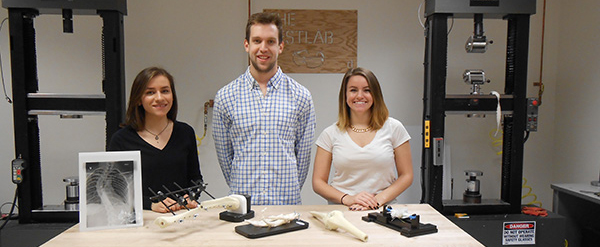OIA brings medical technology into secondary classrooms

An interdisciplinary team of students and faculty from University of Delaware’s College of Education and Human Development and College of Engineering have developed unique curriculum kits, called Orthopaedics in Action (OIA), that teach science, mathematics and engineering concepts through medical experiments.
OIA was created to bridge the gap between engineering and biomedical sciences in high school and middle school classrooms, and to increase student exposure to science, technology, engineering and mathematics (STEM) curriculum across the country.
Five different kits offer interactive hands-on lessons for students to immerse themselves in orthopedics and engineering concepts such as geometry, forces and motions, structural design and trigonometry. Each kit is aligned with Next Generation Science Standards and includes anatomical models and biomechanical testing stations, lesson plans, handouts and video tutorials.
Kits include:
- A broken tibia for students to repair using an orthopedic implant called an external fixator, or “ex-fix;”
- A knee for diagnostic testing;
- Spinal x-rays to examine scoliosis;
- A hand that demonstrates pulley systems; and
- A torn Achilles tendon to practice surgical suturing techniques.
“The OIA project was originally developed as part of the Perry Initiative, a non-profit organization that inspires young women to be leaders in orthopedic surgery and engineering,” said Jenni Buckley, assistant professor of mechanical engineering and co-founder of The Perry Initiative. “As the students’ anatomical model prototypes were being finalized, I thought it would be beneficial to bring in an education professional to see how OIA could be implemented in classrooms.”
Amy Trauth-Nare, associate director for science education at UD’s Professional Development Center for Educators, was able to provide that expertise. She helped Buckley develop learning objectives, create pre- and post-surveys to measure effectiveness, craft precise language for instructional material, and identify the amount of digestible information for students.
They are designed to help teachers, as well as students meet the new NGSS standards. Evaluations will continue, with additional model prototypes being considered. Professional development sessions were held over the summer 2015 in Newark, Delaware and San Francisco, California. The goal is to have OIA kits in 100 classrooms by the end of 2015.
Results from a Pilot Implementation of a Biomedical Engineering Program for Middle and High School Students (Evaluation)
The purpose of this study was to evaluate the efficacy of biomedical engineering curricula to teach the engineering design process and enhance students’ ability to apply science and mathematical concepts to engineering problems.
In this study, we developed and piloted five biomedical engineering (BME) lessons in six high schools. Students (n=91) were presented with biomedical problems, and then challenged to design a solution using clinical tools and STEM principles. For instance, in Engineering an Ex-Fix, students were introduced to a patient with a fractured tibia and challenged to design different external fixator scaffolds based on force and motion principles to stabilize the fracture. Students performed mechanical stress tests to quantify each design’s stability. Through ex-fix design and re-design, students learn that placing pins closer to the fracture site reduces the moment arm and rotation, thus making the external fixator scaffold more stable.
Pre- and post-surveys with 4-point Likert scales were administered immediately before (pre-) and after (post-intervention) students participated in the lessons. Surveys contained identical items to gauge students’ perceptions of their:
- knowledge of BME
- interest in BME
- ability to interpret trends in a data set
- confidence in making claims based on empirical data
- understanding of how doctors and engineers work collaboratively, and
- knowledge of the application of mathematics to medical problems.
Additionally, the post- survey included five items related to students’ attitudes towards the five lessons. A pre-intervention baseline was not obtained since these post-intervention items related directly to students’ levels of interest based on their participation in lessons.
Survey scale scores were analyzed using descriptive statistics, paired t-tests to determine pre-/post-differences, and Cohen’s d to determine effect size.
Data analyses indicated students’ awareness of biomedical engineering increased from pre- (M=1.95, SD=.740) to post-intervention (M=2.69, SD=639); t(88)=7.46, p=.000) with a large effect size (d=1.05, r=.466).
Their confidence did not significantly increase for interpreting data, making claims based on evidence, or the application of math to medical problems.
There was a significant increase in students’ interest in biomedical engineering from pre- (M=1.41, SD=.668) to post-intervention (M=1.75, SD=.806 t(88)=3.38, p=.001) with a moderate effect size (d=.447, r=.218).
Lastly, there was a significant increase in students’ understanding of how doctors and engineers work collaboratively from pre- (M=2.90, SD=.539) to post-intervention (M=3.28, SD=.548 t(88)=4.18, p=.001) with a moderate effect size (d=.687, r=.325).
On average, students enjoyed hands-on engineering lessons (M=3.31, SD=.609) and indicated they would like to know more about topics covered in the five lessons (M=2.81, SD=.761). Our data set was not segregated based on demographic variables (e.g., gender, race, and ethnicity) due to small sample size; however, our future work will focus on what differences, if any, exist among these groups who participate in the curriculum.
To learn more, read the article on UDAILY



